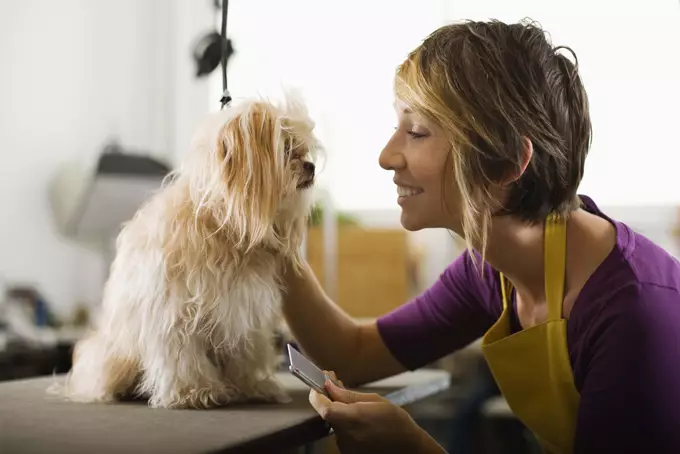Grooming your dog is not merely about aesthetics; it’s a crucial aspect of their health and well-being. Regular grooming fosters a strong bond between you and your pet, enhances your dog’s comfort, and can even help identify potential health issues before they escalate. This article serves to provide an in-depth look at efficient and enjoyable grooming practices for your dog, ensuring that both you and your furry friend find the experience rewarding.
Creating a Calm Environment
A successful grooming session often starts before you even reach for the brush. For many dogs, grooming can cause anxiety or stress, particularly if they’re not accustomed to having their fur touched or manipulated. To create a positive environment, consider grooming your dog after a stimulating activity, such as a walk or play. This can help to calm them down and make them more receptive to the grooming process.
Initially, keep grooming sessions brief—around 5 to 10 minutes—as your dog acclimates to being handled. Gradually increase the duration of these sessions as your dog becomes more comfortable. Handling your dog’s body gently each day, including sensitive areas like their ears and paws, can make a significant difference. Offering praise and treats throughout the process reinforces positive associations. With time, your dog will likely start looking forward to grooming sessions.
Different breeds come with varying coat types, and each has its unique grooming needs. Understanding these differences is key to maintaining your dog’s coat and skin health.
For smooth-coated dogs, like Beagles or Chihuahuas, a weekly grooming session is usually sufficient. Start with a soft-bristled brush to eliminate dead skin and dirt. Follow up with a stiffer bristle brush to remove any loose fur. Wrapping up with a chamois cloth can lend a nice shine, making your pup look polished.
Conversely, dogs with longer and denser coats, such as Golden Retrievers, need a more rigorous grooming routine to prevent matting. Employ a slicker brush to disentangle knots before transitioning to a bristle brush for overall maintenance. Don’t overlook the necessity of combing the tail and legs, ensuring that no hidden tangles remain.
For breeds that boast luxurious long hair, like the Cocker Spaniel or Afghan Hound, daily grooming rituals are essential. Incorporate slicker brushing to combat tangles, followed by a bristle brush for overall texture. Attention must be paid to the areas between the toes and the hocks, as these spots can harbor mats and debris.
Bathing Your Dog Safely
Bathing is another critical component of grooming, and it should be done in a manner that’s both safe and enjoyable for your dog. Vets typically advise bathing dogs every three months; however, active dogs may need more frequent washes. Always use shampoos formulated specifically for dogs to prevent skin irritation.
Prior to bathing, brush your dog to remove any mats. A non-slip mat can enhance safety during the bath. Use lukewarm water—never hot—and avoid spraying water directly on their face or into their ears. Focus on lathering the shampoo thoroughly across their coat before rinsing it all off, again being careful around sensitive areas like the eyes and ears.
During this time, it’s also a golden opportunity to inspect the dog’s ears for any build-up of dirt or wax. Employ a cotton ball dampened with a vet-approved solution to clean them gently.
Nail Clipping and Special Considerations
Nail trimming can evoke fear and anxiety for many pets, but it’s a critical part of grooming that helps in maintaining your dog’s health. Start by familiarizing your dog’s paws with gentle handling. Once they’re comfortable, use sharp and suitable nail clippers to snip just the tip of each nail, avoiding the quick. If you accidentally do clip the quick and bleeding occurs, have a styptic powder handy for such emergencies.
Some dog breeds, especially those with loose skin like Pugs or Shar-Peis, need extra attention during grooming. Cleaning between their skin folds is critical to prevent dirt buildup and potential infections. Regular cleaning with damp cotton can keep these areas dry and healthy.
Further, some breeds with long droopy ears, such as Basset Hounds, are prone to ear infections. Regular checks and cleanings can avert potential health issues, preserving both their hearing and overall comfort.
Grooming doesn’t have to be a dreaded task. Through patience, consistency, and positive reinforcement, both you and your dog can look forward to these grooming sessions. Incorporate treats, toys, or even soothing music to create a relaxing ambience. Over time, grooming can evolve from a chore into a cherished bonding time between you and your beloved canine companion.
Investing time in grooming not only enhances your dog’s appearance but is also an essential avenue for health maintenance and relationship building. With the right approach and techniques, grooming can become an enjoyable ritual that you both look forward to.

